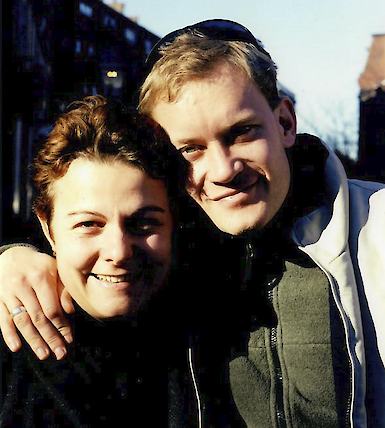Accessibility and privilege in grief support
A few weeks after my husband died, my friend Shannon poured me into the back seat of her car and drove me to a therapy session with an organization that provided free, one-on-one counseling for people like me, whose lives had been torn into a million little pieces by the suicide of someone we loved.
Every Wednesday, for 3 years, I fell headlong into those therapy sessions, where I let loose my rage, collapsed in despair, worried that I was somehow a murderer, admitted that it was hard to get out of bed, and more. I’ve often felt that those therapy sessions saved my life. Instead of pushing down complicated feelings and being ashamed, I discovered deep pools of resilience and meaning. I eventually accepted that Barry’s suicide wasn’t my fault, found healthy ways to grieve, and began to believe that I could not only survive, but thrive.
If those therapy sessions had cost $150/hour, I wouldn’t have been able to afford them.

If I’d had to travel for an hour to get that support, I wouldn’t have gone. Back then I couldn’t drive or even make a phone call half the time.
If I hadn’t found a therapist who I could relate to, and who I felt comfortable with, I wouldn’t have continued.
In other words, grief support was affordable and accessible for me. I was lucky. Most people don’t get the support they need after someone dies, and that is bad news for individual mental health, as well as for the development of healthy families and communities.
Rigorous population-level studies examining the health behaviors and outcomes of millions of individuals find that bereaved parents, siblings, children and spouses are all at risk of premature death, as well as a host of other poor health, social and economic outcomes, as a result of such loss. Grief increases the likelihood of anxiety, depression and lost income, for example.
Grief also provides a window into inequity. Black Americans are three times more likely to lose a mother, more than twice as likely to lose a father and 20 percent more likely to lose a sibling by age 10 than White Americans. They are also significantly less likely to access bereavement resources, due to factors including cultural alienation, socioeconomic status, and lack of access to health care.
I left my tech career to work full time in grief and loss because, despite all our data and knowledge about the negative impacts of grief, not enough is being done to make bereavement care available and accessible for everyone who needs it. Waiting lists, hourly rates, geography and cultural distrust make grief support inaccessible for many Americans.
Now COVID-19 is increasing mortality rates and disproportionately impacting Black and Hispanic Americans, and shining a hard light on the gaps in bereavement care in this country. For every one of our 200,000+ COVID-19 deaths, approximately nine Americans will survive having lost a grandparent, parent, sibling, spouse or child so the need is immense, and growing.
So what can we do to make sure the people we care about don’t have to grieve alone? Advocates like Joyal Mulheron at Evermore believe that the lack of high-quality bereavement care for Americans constitutes an invisible public health crisis, and are pushing our governments to make grief support accessible and affordable for all. In the meantime, if we can set aside our fears there are lots of simple ways to help.
- In my work I hear – everyday – from grieving people who feel alone, because their friends and family stay away or don’t know what to say to them. It’s normal to feel fearful and awkward when someone dies, but if we can set aside our fears there are lots of simple ways to help. It never ceases to amaze me how much grieving people appreciate just being able to talk about the person they’ve lost, for example.
- Contact a local hospice to see if they have free grief support programs available. Many hospices extend their grief support services to community members, and hospice bereavement managers are caring, experienced people with a vast knowledge of grief and loss.
- Educate yourself after someone dies. Resources like What’s Your Grief have lots of rich wisdom that can help you feel more confident reaching out to grieving loved ones. If you want tips and suggestions right to your phone, sign up for a Grief Coach subscription to receive personalized texts all year long, with suggestions about how to support your grieving loved one or to help you navigate your own grief.
- Join an Option B support group to find a community of people who are supporting each other in their grief. These closed Facebook groups are for members only, and are available 24/7.
- Reach out to your company’s HR department to see if they offer bereavement benefits. Companies are increasingly including bereavement benefits as part of their wellness packages, as they recognize the role of grief in the workplace and the opportunity to provide support. Employee Benefit News ran a piece recently about bereavement benefits.
I look forward to the day when grief support will be accessible and available for everyone who needs it. Employers, policy makers, practitioners and insurers all have a role to play. In the meantime, and at a time when so many Americans are experiencing loss, I am grateful to the courageous friends, neighbors and colleagues who are finding ways to support their grieving friends.
If you have a friend, family member or colleague who has lost a loved one, find a way to be part of their journey, so they don’t have to grieve alone.